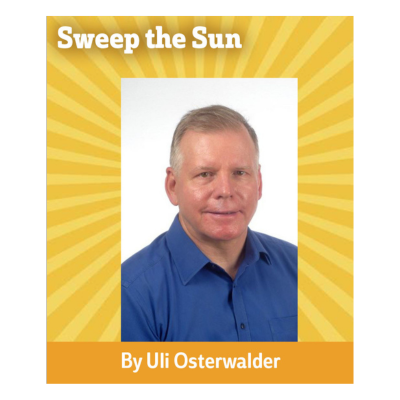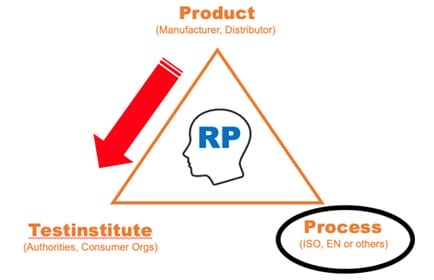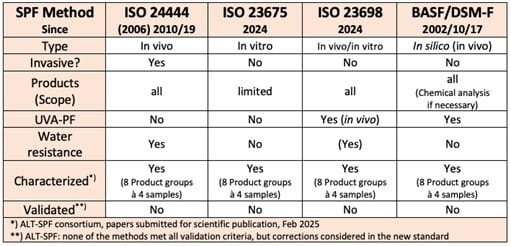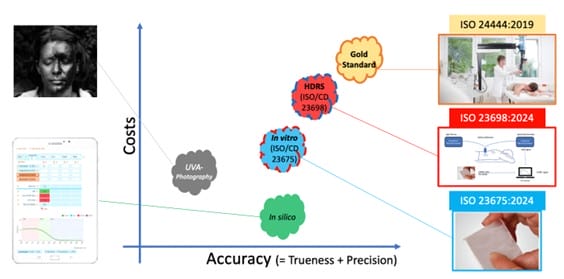
By Uli Osterwalder
Over the past two years, I have described the SPF test method and its alternatives several times. In my last column, “Two additions to the SPF toolbox!” in January 2025, two new alternative methods were presented [1-3]. Particularly in Europe, I am seeing some confusion about what exactly this means. The framework for SPF testing is currently uncertain. There is pressure to use the new in vitro/non-invasive methods. Various factors need to be weighed up:
- Which method applies?
- Accuracy? / Cost?
- Which method is used by?
- Authorities
- Consumer organizations
1. The importance of sun protection
Before we discuss the different methods, we should be aware that topical sun protection is an important issue. Topical sunscreens can prevent sunburn by converting UV radiation into harmless IR radiation. This also helps to reduce the number of cases of skin cancer and less serious skin diseases (e.g. melasma) or cosmetic indications (e.g. hyperpigmentation) [4-7]. In some countries, such as Australia, Canada and the United States, topical sunscreens are regulated as “OTC drugs”. Claims such as “helps prevent skin cancer” may then also be made. This is not permitted under cosmetics regulations.
2. Stakeholder Expectations
We can distinguish three major groups of stakeholders, 1) Sunscreen manufacturers and Distributors, 2) Monitoring authorities and consumers organizations and 3) Process holders and developers such as ISO, CEN and national standardization organizations, as depicted in Figure 1.
The “Red Arrow” signifies that fact that some manufacturers and distributors of sunscreen, especially in the Netherlands, e.g. KRUIDVAT, are calling on public authorities and consumer organizations to reach joint, unanimous agreements on how to test sun protection products. [8].
The results of a Consumer Association sunscreen test that tested a Nivea product, among others, prompted BEIERSDORF to respond with the statement below: ‘We completely disagree with The Consumers’ Association’s publication. We extensively test all our Nivea Sun formulas and their labeled SPFs according to internationally standardized testing methods. These tests are carried out blind by independent and validated testing institutes to always guarantee the consistent, high-quality efficacy and consumer safety of all Nivea Sun products….” [9].
The title of an RTL news article is: If you go to the beach soon, don’t use Nivea or Kruidvat sunscreen, says consumer organization. The “afraders” are angry and disappointed. Bad losers, or is there more to it than that? Naïf, which did poorly in last year’s sunscreen test, is so annoyed that the company has hired a lawyer [10].
The “process” in Figure 1 is circled to highlight the role of the standards we are discussing here. The focus is on the “ responsible person”, the RP for the product, as defined in the EU Cosmetics Regulation. There, the RP must know and understand the perspective of all three stakeholder types.
Although in vitro SPF methods have existed for half a century, there were no official alternative SPF ISO standards until the end of 2024. During this period, it was therefore clear that, in case of doubt, ISO 24444:2019 was the gold standard. Some stakeholders argue that from now on all official methods can be used equally or even that only the in vitro ´pure´ method should be used, based on the 2006 European Commission recommendation. There are no explicit guidelines telling us what is right or wrong.
In such situations, it seems sensible to keep a cool head and, for example, to turn to the actual goal, which is to ensure that sun protection products provide the protection they promise, and to do so for real people in vivo. The new alternative methods must provide equivalent values for sun protection, expressed as an SPF, that correspond to the gold standard ISO 24444
 |
| Figure 1 Stakeholder – Triangle (Quality Assurance Triangle) |
3. Overview of ISO methods and in silico method(Figure 2)ISO 24444 (Gold Standard) can determine the SPF of practically any product. However, only a single endpoint is determined, namely the SPF value, integrated over the entire UV spectrum.
ISO 23675 (DPM, transmission with 2 plates) can measure practically all products, with minor limitations, e.g. no single-phase oil formulations. The result range goes far beyond ISO 24444, with detailed information over the entire UV range.
ISO 23698 (HDRS, Hybrid Diffuse Reflectance Spectroscopy) can be used to determine the SPF of any product that can be measured with ISO 24444 and ISO 24443 (UVA-PF). The result range goes far beyond ISO 24444, with detailed information over the UVA range from 320 to 400 nm (in vivo) or over the entire UV range (in vitro).
BASF/DSM-F (In silico, calculation) The range of results goes far beyond ISO 24444. Any conceivable metric can be determined. However, it must be checked whether the selected UV filter combination can be formulated as a sunscreen product. If the UV filter combination is unknown, it can be determined by analytical means (EN 17156:2018 or EN 16344:2013).
 |
| Figure 2 Overview three ISO methods and in silico method (BASF/DSM-F) |
Figure 3 shows the current state of the SPF toolbox. With the help of the upcoming publications of the “ALT-SPF” results, it will be possible to confirm or correct the current positions of the tools (methods) in terms of accuracy/cost. The goal, of course, is to obtain SPF results that are as accurate and reliable as possible, at a reasonable cost. The UVA photography that is also included in Figure 3, is an excellent way to raise awareness of sun protection, but it is not accurate enough to quantify SPF.
 |
| Figure 3 SPF–TOOLBOX: Cost/Accuracy Position of SPF Methods (tentative) |
4. How to introduce and adopt the new SPF methods?
The fact that there are now three ISO standards is a challenge and raises questions:
- Which standard should be used?
- What if the results of the same methods are different?
- What if the results of different methods are different?
The aim is to obtain the most reliable SPF values at a reasonable cost. Accuracy is defined in ISO 5725:2023 as trueness plus precision. With the gold standard ISO 24444, it is inherently difficult to measure reproducibly, and it comes at a relatively high cost. In vitro methods may have higher reproducibility and therefore precision but may measure less accurately as the measurement principle is further away from reality. We now have an SPF toolbox (Figures 2, 3) at our disposal; in addition to the three international ISO standards, the SPF can be calculated using the BASF sunscreen simulator and/or the DSM-Firmenich sunscreen optimizer. These simulators are a good starting point – let’s use the SPF tools in an intelligent way!
4.2 Example of sunscreen formulations with a high ZnO content
It has long been known among insiders that sunscreens with high concentrations of zinc oxide as the only UV filter, the SPF values measured in vitro tend to be systematically lower than those measured in vivo [11]. A mini-consortium along the lines of ALT-SPF will address this issue and make proposals for the adaptation of ISO 23675:2024 for this product group
4.3 Other potential formulations with lack of equivalence between methods?
It is to be expected that, as experience with alternative methods grows, findings will be made that reveal problems with the equivalence of SPF values between different methods for certain products or product groups. It is important to process such findings transparently and scientifically in order not to disadvantage any products or product groups and also to further develop the methods.
5. Conclusion
The long-awaited non-invasive SPF testing methods are now available. This has already led to some confusion in the European market. Manufacturers and distributors of sun protection products are calling on authorities and consumer organizations to end this confusion. The European Commission recommendation clearly states that in vitro methods are preferred, but also that they must be equivalent to the in vivo method [12] (gold standard ISO 24444). After all, the aim is to protect humans in vivo. In order to gain experience with the new methods for the many different products on the market, a transition period of five years seems appropriate.
Stay tuned!
References
- Osterwalder U, Two Additions to the SPF Toolbox, EURO Cosmetics News Letter, https://www.eurocosmetics-mag.com/two-additions-to-the-spf-toolbox/, 2025
- Osterwalder U, AIternative SPF-Methods on the Doorsteps, EURO Cosmetics News Letter, https://www.eurocosmetics-mag.com/alternative-spf-methods-on-the-doorsteps/, 2024
- Osterwalder U, AIternative SPF Methods, EURO Cosmetics News Letter, https://www.eurocosmetics-mag.com/alternative-spf-methods/, 2023
- Tips for sun protection https://www.bfs.de/DE/themen/opt/uv/schutz/tipps/tipps_node.html
- Sun Protection Factor Determination Guidelines https://www.obelis.net/news/sun-protection-factor-determination-guidelines/
- Why sun protection is important. https://www.reidhealth.org/blog/why-sun-protection-is-important
- Put on Your Sun Armor! https://news.christianacare.org/2023/06/put-on-your-sun-armor/
- Kruidvat, A.S. Watson Health & Beauty, Consumer Association sun protection test confuses consumers, Kruidvat disagrees with the publication of the Consumers’ Association sun protection tests, Press Release, Renswoude, 14 May 2024
- Beiersdorf (Nivea) responds to Consumer Association sunscreen test, 15 May 2024
- Yoo Sang-Ah, Disagreement over test method, Heated tempers over sunburn test Consumers Union: ‘Deception’, RTL News, RTL.NL, June 1, 2024
- Osterwalder U, Hubaud JC, Perroux-David E, Moraine T, van den Bosch J. Sun-protection factor of zinc-oxide sunscreens: SPFin vitro too low compared to SPFin vivo-a brief review. Photochem Photobiol Sci. 2024 Oct;23(10):1999-2009. doi: 10.1007/s43630-024-00644-0. Epub 2024 Oct 21. PMID: 39432202.
- COMMISSION RECOMMENDATION of September 22, 2006 on the efficacy of sunscreen products and the claims made relating thereto. Official Journal of the European Union. L 265/39. Available from: https://eur-lex.europa.eu/legalcontent/EN/TXT/PDF/?uri=CELEX:32006H0647&from=CS , viewed October 12,2020.

Uli Osterwalder
Uli Osterwalder studied Chemical Engineering at ETH Zurich, Switzerland and at the University of Houston in Houston, Texas. He joined Ciba-Geigy in Basel in 1979 where he first developed a Phosgene Generator in central process development. Later he developed his leadership skills in Project Management and Process Analytics. At Ciba Specialty Chemicals Uli Osterwalder helped establish new business development in Fabric Care and Personal Care. After the acquisition by BASF SE he became Senior Marketing Manager and Scientific Adviser in Sun Care in Ludwigshafen and Duesseldorf.
2016 he came back to Basel, working for DSM as senior Senior Scientific Adviser suncare for two years. 2018 he started his own company, Sun Protection Facilitator GmbH and is committed to contribute to further improvements in sun protection. Uli Osterwalder works for ISO on the development of new UV protection assessment methods and is now chairing the technical committee ISO TC/217 (Cosmetics). He is author and co-author of numerous scientific articles and book chapters on sun protection.



